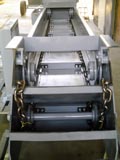
Wet De-Ashing System
Type 1
Application: Wet de-ashing of fine to coarse ashes and slags on all feed grate and traveling grate firing systems
Capacity Range: max. 1 t of ash/hr.
Transport Width: up to 0.3 to 1 m (12 to 40”)
Transport Length: horizontally up to 20 m (65’), vertically up to 10 m (33’), angle of climb 45°
Technology: The wet de-ashing system is designed as a scraper chain conveyor with a horizontal and increasing segment, including drive station with geared motor, clamping station and water level control. Sealing towards the firing system through dip nozzles in the water. Drag chains as hardened round steel chains.
Type 2
Application: Wet de-ashing of fine to coarse ashes and slags on all feed grate and traveling grate firing systems
Capacity Range: max. 1.5 t of ash/hr.
Transport Width: up to 0.4 to 2 m (16 to 78”)
Transport Length: horizontally up to 20 m (65’), vertically up to 10 m (33’), angle of climb 45°-60°
Technology: The wet de-ashing system is designed as a scraper chain conveyor with a horizontal and increasing segment, including drive station with geared motor, clamping station and water level control. Sealing towards the firing system through dip nozzles in the water. Wear plate in “Hardox”. Drag chains as hardened round steel- roll link or plate link chains.

De-ashing Screw
Application: Dry de-ashing of fine to coarse ashes from all furnaces, boilers and flue-gas systems
Transport Length: up to 8 m (26’), (single screw)
Capacity Range: up to 400 kg (890 lb.) of ash/hr., screw diameter 100-300 mm (4-12”)
Technology: Trough screw conveyor and tubular screw conveyor in sturdy design with spindle bearings on both sides. Optional with temperature resistant screw pitch and temperature decoupled bearing and gear motor. LAMBION offers complete ash removal systems with combinations of several in series and parallel arranged de-ashing screws matching the respective boiler system.







